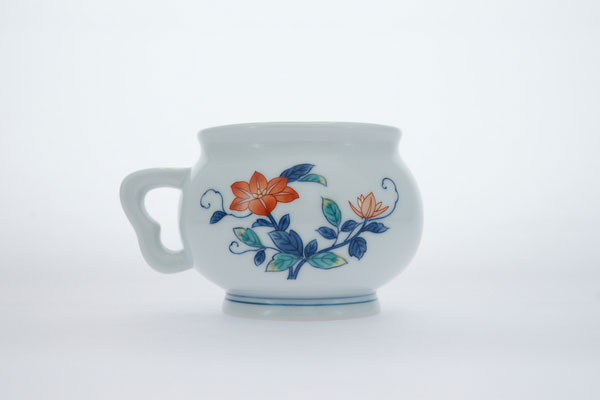
- Ceramic
- Saga
Imari ware/Arita ware Imari yaki Arita yaki
Japan's delicacy and grace in three colors:
Vivid white, red and indigo potteries
Description
What is Imari ware/Arita ware ?
Imari ware and Arita ware are both porcelain produced around the town of Arita, in the Saga prefecture. Imari ware and Arita ware are light and delicate and both have excellent durability because their porcelain is produced from porcelain stone. Their characteristics are a fine, smooth texture and a color scheme of dyed indigo and bright red asbolite on transparent white porcelain. Originally, Imari ware and Arita ware were almost the same, both produced in the area around Arita (including Mikawachi and Hasami). They came to be called Arita ware and Imari ware as these were the names of the stations and ports used for shipping them. The ceramics known today as Mikawachi ware and Hasami ware also used to be sold under the names of Arita ware and Imari ware. Today, Arita ware describes pieces that were baked in Arita and Imari ware describes pieces that were baked in Imari. However, Koimari does not refer to pieces that were baked in Imari, but rather describes pottery produced up to around the year 1650.
History
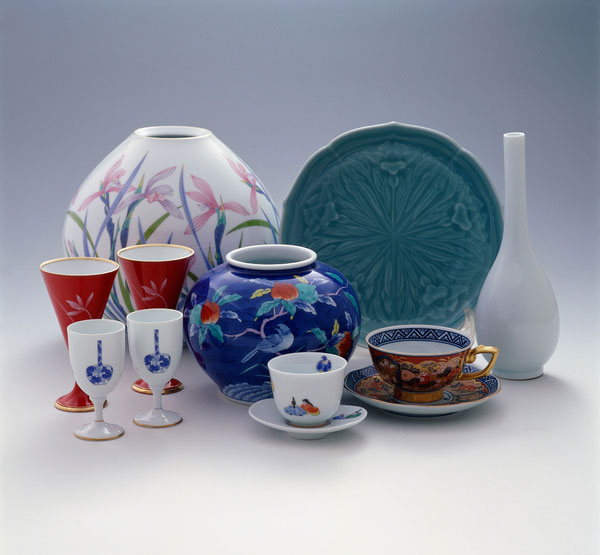
The origin of Imari ware/Arita ware goes back to the year 1616, during the Edo period (1603-1868). The history of porcelain began when porcelain stone was discovered by Sam-Pyeong YI, who came from Korea with Naoshige NABESHIMA. Most of the productions around 1650 were simple, a thick pottery finished only with gosu (zaffer, creating a blue color). Overglazing was not yet carried out at this time, but in 1647 artisans started using overglaze with the first generation of the Kakiemon SAKAIDA family. Furthermore, in the 1640s, ceramics with red paintings called aka-e became the symbol of the Kakiemon-style ceramic and was even imitated by the famous porcelain manufactory Meissen. By 1688, a gorgeous style of Imari ware/Arita ware was created : the "kinrande style". Shades of gold and red were used to draw patterns on the entire surface of the pottery. In 1870, a Wagner-inspired coal kiln was built and cobalt began to be used as a raw material for gosu porcelain. This type of work spread very quickly nation-wide.
General Production Process
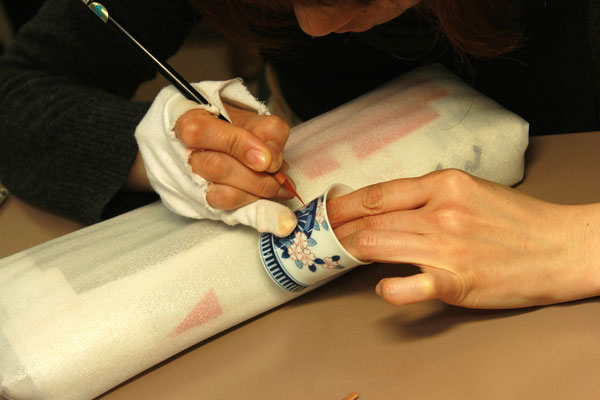
- 1. Making the clay Porcelain stone is mined and sorted into Izumi porcelain stone and Tengusa porcelain stone. The sorted porcelain stone is then mechanically grounded into a fine powder. First, it is broken down to a certain size with a crusher, then it is turned into a fine powder with a stamper and finally it is placed inside a water tank filled with water for elutriation. The process of elutriation removes impurities such as iron. After excess moisture is removed the potter’s clay is complete.
- 2. Molding A potter’s wheel is used for molding, but before that the clay is kneaded. The purpose of kneading the clay is to remove air from inside the potter’s clay and to make the moisture and grains uniform. If there is air or any unevenness in the potter’s clay this could result in damage such as cracks. Moreover, clay kneading is also known as 'clay wedging', and in all ceramic arts this is an essential process. After the potter’s clay has been kneaded, it is molded using a mechanical or hand-powered potter’s wheels, templates or molds.
- 3. Finishing / Drying Once the molding has been completed, detailed parts such as the feet, handles and edges are produced. If the unglazed pottery is dried too suddenly, it will cause damages such as distortion, so it is important to carry out the drying process slowly.
- 4. Biscuit firing
Pieces that have been thoroughly dried are then fired at around 850 to 950℃. This process is called 'biscuit firing' as it is the first firing before any glaze is applied.
In the case of biscuit firing too, damage is prevented by gradually raising the temperature, without making any sudden temperature increases. Likewise, cooling is also carried out gradually to prevent damage.
- 5. Underglaze decoration Decoration is applied after the biscuit firing before glazing. The pigment often used for decoration is asbolite dye called gosu in Japanese, with cobalt oxide as its main ingredient. The beautiful indigo blue of Imari ware/Arita ware is expressed by means of this asbolite dye. The color gradations are made with water, rather than using different pigments. When making detailed designs, line drawing and painting between the lines are sometimes done at this stage.
- 6.Glazing The process of applying the glaze thinly and evenly after the decoration is known as 'glazing'. By firing the glaze, the glaze become glassy which therefore reinforces the pottery, smoothens the surface, produces a beautiful luster, and prevents stains. Glaze is then wiped off the base and the pieces are dried thoroughly.
- 7. Glost firing Once the glaze has dried, pieces are baked at a high temperature of around 1300℃ for about 16 hours. Pieces that do not require on-glaze decoration are complete once glost firing has been carried out.
- 8. On-glaze decoration Applying additional decoration on pieces that have been glost fired is called on-glaze decoration. Decoration with red paint, which is a characteristic of Imari ware and Arita ware, is also carried out at this stage. Since the pigments used for on-glaze decoration have temperature restrictions, the firing temperature of the kiln is set quite low, at around 700 to 800℃. Also, when applying gold or silver painting using gold or silver leaves, another process is necessary after the firing. It is known as nishikigama or kingama: glaze is applied after the gold or silver painting, and the pieces are fired at a low temperature of around 400℃.
Leading Ateliers
Gen'emon-gama atelier
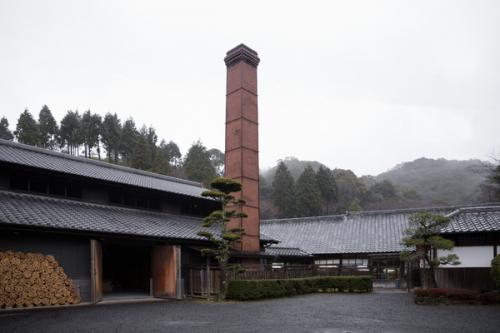
Japan's delicacy and grace in three colors: Vivid white, red and indigo potteries
-
Founded1753
-
ClosedOpen all year long except around the New Year
-
DirectorMasashi KANEKO
-
Business Hours8am to 5pm / Sat, Sun and holidays: 9am to 5pm
-
Address
-
Website
-
Tel.+81-955-42-4164
Kakiemon-gama atelier
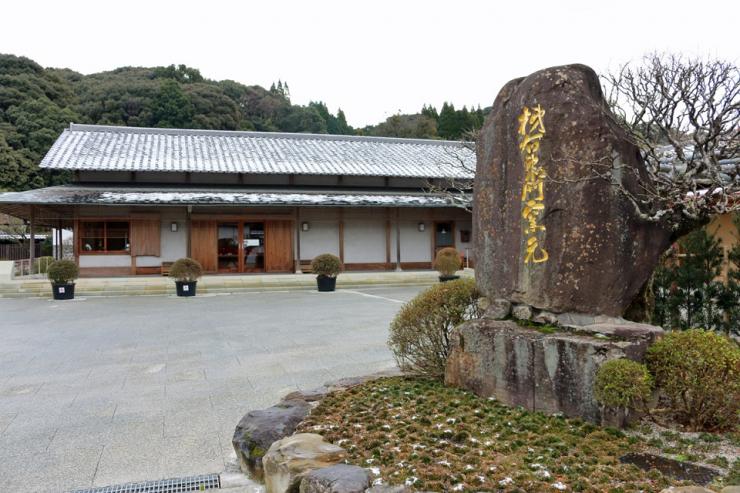
Japan's delicacy and grace in three colors: Vivid white, red and indigo potteries
-
Founded1616
-
ClosedOpen all year long
-
DirectorKakiemon SAKAIDA
-
Business Hours9am to 5pm (different hours around the New Year)
-
Address
-
Tel.+81-955-43-2267
Where to Buy & More Information
Imari-Arita Traditional Industries Hall
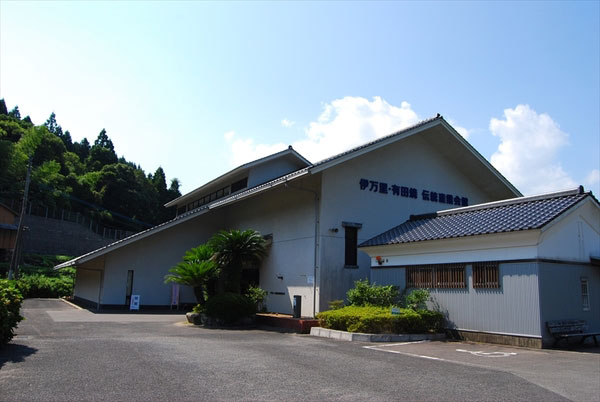 Photo:Saga Prefectural Tourism Federation
Photo:Saga Prefectural Tourism Federation
-
Address
-
Tel.+81-955-22-6333
-
ClosedAround the New Year
-
Business Hours9am to 5pm
-
Website
See more Ceramic
- Imari ware/Arita ware
- Hasami ware
- Kutani ware
- Mashiko ware
- Shigaraki ware
- Bizen ware
- Hagi ware
- Koishiwara ware
- Mino ware
- Tobe ware
- Tokoname ware
- Karatsu ware
- Kasama ware
- Satsuma ware
- Iga ware
- Mikawachi ware
- Agano ware
- Otani ware
- Obori-soma ware
- Tsuboya ware
- Aizu-hongo ware
- Shodai ware
- Echizen ware
- Akazu ware
- Tamba-tachikui ware
- Yokkaichi-banko ware
- Izushi ware
- Kyo ware/Kiyomizu ware
- Iwami ware
- Amakusa ceramics
- Seto-sometsuke ware
- Sanshu Onigawara Crafts































































































































































































































































































